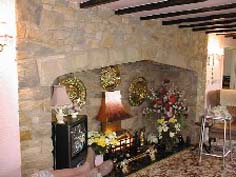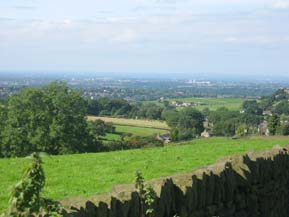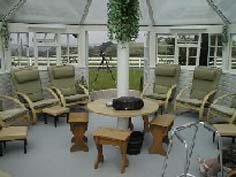Our Facilites
Mellor Nook's design is an important influence on the residents' qualify of life. The design has been geared to satisfying the needs of residents and staff providing care within the home while keeping the charm of a rural farmhouse.

Mellor Nook:
· Provides a safe and secure environment for residents;
· Ensures their privacy and provides their own personal space under their own control;
· Protects their dignity;
· Offers them a stimulating setting for daily activities;
· Enables them to have easy access around the home; minimises residents' difficulties in understanding their surroundings;
· Provides a work setting which enables staff to deliver high quality care;
· Meets the standards relating to the design and fabric of residential care home required by law, regulations and directives.
Over time, expectations have risen and standards are continually improving. Mellor Nook is committed in providing many of the features outlined here.
Location and setting
Mellor Nook is set in a wonderful rural setting. And is accessible to public transport, local shops and other community facilities such as pubs and libraries,
Access to the local community
Mellor Nook maintains good community links. In some cases residents may be frail and unable to get out and about but they still value links with the local community, schools, community organisations and places of worship.
Transport
If residents cannot get about by themselves, we have our own transport for outings and trips to shops and places of worship, and arrange for friends, relatives and volunteers to accompany them. Such help can also be arranged for relatives and friends who have no transport of their own and who cannot use public transport. Car parking for visitors (and residents in some cases) is also available.
Views and aspect
First impressions of Mellor Nook are its setting and the building itself. Open views on to gardens and the surrounding countryside are important. Mellor Nook has well designed landscaping and great pride is taken in all the grounds.
Building design
 Mellor
Nook is a converted farm house which is very unusual for a care home but
its this that makes Mellor Nook a totally individual and unique It is
for this reason that at times it has been hard for Mellor Nook to comply
with regulations to do with the building. However this is not taken as
a reason to avoid meeting certain standards These are the standards which
guarantee the privacy and dignity of residents, promote their independence
and enable them to live their lives in the way that suits them best. Some
standards are ruled by legislation, regulations and guidance; others are
set by national associations (of the professions, homeowners and others)
or are the outcome of agreement between Mellor Nook and inspection and
registration units.
Mellor
Nook is a converted farm house which is very unusual for a care home but
its this that makes Mellor Nook a totally individual and unique It is
for this reason that at times it has been hard for Mellor Nook to comply
with regulations to do with the building. However this is not taken as
a reason to avoid meeting certain standards These are the standards which
guarantee the privacy and dignity of residents, promote their independence
and enable them to live their lives in the way that suits them best. Some
standards are ruled by legislation, regulations and guidance; others are
set by national associations (of the professions, homeowners and others)
or are the outcome of agreement between Mellor Nook and inspection and
registration units.
Improvements
Since 1988 Mellor Nook has constantly improved the accommodation as and when possible, either as part of the development programme or, for example, redecorating between residencies.
Such improvements have included:
· Phasing out all shared rooms (apart from one or two, for couples);
· Using former double rooms for single rooms with en suite facilities or for activity rooms;
· Where practicable, adding en suite facilities to rooms;
· Adopting a policy of redecoration between residencies, ideally with the new resident taking responsibility for deciding what should be done;
· Personalising doors with nameplates and pictures;
· Building a summer house;
· Improving access to the garden and incorporating new features for example, the greenhouse, and raised flowerbeds.
Size of home and living units
The size of home is governed by the fact that Mellor Nook is in Greenbelt land (unusual for a care home): The central aim is to support and enhance the quality of life for residents, the fostering of individuality and the maintenance of privacy and dignity
Unit or group living
Our aim is, regardless of the overall size of the home, for life to be on a domestic scale for every resident. Residents are able to identify with a group of other residents within the home.
Domestic style
Every effort has been made to prevent the home from having an institutional feel. The setting, design and decoration of the building all contribute to this (along with the way in which staff and management operate). The chart on the following page sets out some of the differences:
A supportive environment
We recognise that older people may have restricted mobility or sensory impairments. Some may show signs of the onset of dementia. Supportive features are incorporated so as to minimise and compensate for all these difficulties. The following design characteristics have been important:
· It is be easy for residents to find their way around the building. Each resident can easily locate their own private space, identify how to get to a toilet wherever they are in the building, know where and how to find help and assistance, and know how to get to sitting areas;
· There are simple, obvious routes around the building, with points of interest as 'landmarks' (for example, plants or pieces of furniture) so that the individuals know where they are.
· Long featureless corridors with similar-looking doors and dead-ends are confusing and don’t exist at Mellor Nook.
· There is easy movement between all parts of the building with doors which can be opened easily and used by people with walking frames or sticks;
· There is a stair lift to upper floors.
· Easy-to-climb stairs with handrails both sides
· Good levels of lighting , no changes of floor levels. Good lighting is important in helping to reduce confusion. Lighting which casts shadows on to floors has been avoided because they can be misinterpreted for example, they may give the impression that there is something to step over;
· All specially designed fixtures and fittings, for example in toilets and bathrooms, are as much as possible in as domestic-style.
· The use of technology is sensitive, for example nurse call systems which are non-intrusive;
· Residents rooms are personalised with their own fittings and furniture (where possible) and other bits and pieces which have meaning for the individual;
· A smaller lounge and the summerhouse as well as the larger lounge help people to mix with each other.
· Mellor Nook provides a safe environment which provides a balance between overprotection and risk with unobtrusive fire and security precautions;
· There is access to a safe and interesting garden with 'wandering' paths
that is, a route which leads a person through the garden and back into
the building unobtrusively.
Pleasant environment
In addition to being functional, the building is a pleasant and secure environment in which to live. Attention has been paid to the aesthetic qualities of a building. For example:
· Lighting, especially the maximum use of natural daylight;
· The imaginative ornaments and decorations;
· Having points of interest which may provide stimulation and conversation;
· A variety of usable spaces both inside and outside the building, some of which are semi-protected for example, porches, and summerhouse.
Gardens
The gardens at Mellor Nook are an important part of the premises. They are safe for people to walk in, without steps and accessible for wheelchairs. Security measures are unobtrusive but reliable. Seats at strategic points with sheltered and shaded areas enable residents to spend time outside. Raised flowerbeds, herb gardens and the greenhouse make it easier for residents to take an active interest in the garden.. People who are visually impaired value scented gardens. Birds and other wildlife are encouraged.
Common facilities
Facilities and space that are shared by residents have been provided
in domestic-style and are interesting and varied.
Communal rooms
Both communal space and personal accommodation is very important at Mellor Nook. The rooms are well decorated and accessible for everyone. Efforts have been made to ensure that common space is welcoming. For example, minimising noise so not disorientating people.
Within the rooms:
· Chairs and furniture are of different styles and heights;
· Easy chairs are domestic in appearance for example not be covered in a plastic;
· Side tables are available (waist-height for drinks, papers, paraphernalia);
· Chairs are not just be arranged around walls (unless for a special occasion or because residents prefer this) because small groupings are more homely and intimate;
· Furniture is arranged for easy access, both to allow use of walking frames and to provide support for those who have difficulty walking;
· Fabric and furnishings are all fire-retardant.
Activity rooms
Rooms are available for a variety of activities. Options include:
· A quiet room and for reading;
· 10 aches of land to participate in any activity;
· Use of the dining room by residents, for large meetings with families and friends etc.
Connecting spaces
All corridors and entrance lobbies:
· Have level access and meet all the mobility criteria;
· Have sufficient width and space for wheelchairs and walking frames
· Minimum the distance between private and communal space;
· Provide a variety of spaces for sitting and looking out of a window.
Toilets, bathrooms in common areas
Access to toilets in common areas is aided by having them situated close to the lounges and activity rooms’ privacy in using the toilets is an essential consideration. Mellor Nook provides facilities in the following ratios:
· Toilets/residents, 1:4;
· Bathrooms/residents, 1:8.
Toilets have been designed with mobility and disability in mind without having a clinical appearance. Bathing equipment is as domestic in style as possible. Staff endeavour to minimise fear when using the bath hoist
Storage space
There is ample space to store luggage, spare equipment including hoists, furniture and other bulky items that are infrequently used. Proper storage is also provided for wheelchairs and walking frames
Residents' own accommodation
The single most important aspect of living in residential care is the living accommodation provided for the individual resident. All research shows that most residents prefer a single room. However some people do prefer to share a room they feel less alone and less vulnerable.
Single occupancy
People moving into Mellor Nook can chose to have their own single room accommodation (unless they prefer otherwise). We strongly recommended that shared rooms are available for couples; relatives or close friends are able to live together if they so wish.
Shared occupancy
Two people only live in the same accommodation if they have chosen to do so. The accommodation is specifically designed for two people (in terms of size and facilities), paying due account to privacy.
En suite toilet and washing facilities
Careful design has reduced the amount of space taken from the living area of the accommodation although it must be recognised that installing en suite facilities into existing accommodation eats into available space and can therefore has only be done where practicable. There is a vanity unit and storage space for toiletries. Toilets are a comfortable height with built-in support. Taps designed for people with weak or arthritic hands have been fitted.
Suitability of accommodation
There are a number of factors we have considered when designing the accommodation most were checked prior to registration and the following is what we took in to account. Some of which makes up the improvement programme.
Size of room
The total area of a room is one of the key input measures that were checked by inspection and registration units before registration. The generally accepted minimum size is ten square metres for single accommodation. We aim to ensure that over time our provision will enable residents to have their own private rooms large enough to hold a reasonable amount of their own furniture and to accommodate all the activities of daily living that a resident can expect to carry out. There is room for an armchair, a television and other leisure activity paraphernalia. There is space for manoeuvring a walking frame and for staff to provide assistance. It is also be possible to move the bed into alternative positions, including into the centre of the room should access be required from both sides for certain types of care
Other factors
Other factors we considered include:
· The proportion of a room (in keeping with a cottage atmosphere);
· There is adequate soundproofing to ensure residents are not unnecessarily disturbed by outside noise. But care was taken so not to make the residents feel isolated and cut off from the normal bustle of daily activity;
· Where a room doesn’t have as good a view as some rooms effort has been made to counteract this by, for example, planting a shrub or growing climbing plants;
· Window(s) are of an adequate size are of good proportion in relation to size of room. all the window-sills are low enough for the resident to look out without obstructed vision when seated or when lying in bed.
Furniture
The accommodation at Mellor Nook is large enough to contain:
A bed (three feet wide);
· One comfortable armchair;
· Storage space for clothes, i.e. a chest of drawers and hanging space;
· Storage space for other possessions i.e. shelves, cupboards;
· Lockable strongbox for money and valuables.
Doors to bedrooms
We recognise that Doors represent, both physically and psychologically, the entrance to a resident's private space therefore, that as far as possible the resident controls who enters, all residents are given a key and staff and visitors always knock and wait for an invitation to enter.
Locks
Doors to resident’s rooms are lockable from both sides with staff holding a master key in case of emergency. As far as possible, residents hold their own keys with no restriction as to when they can lock the door.
Opening doors
Doors are easy to open for people who are frail. Where appropriate, their wishes to keep doors open is respected.
Identification
The outside of doors every residents room has their name and picture on it so that residents can easily recognise their own door.
Furniture, fittings and decoration
It is normal practice for people to bring some of their own suitable furniture with them when moving in on a permanent basis. They can decorate and furnish their rooms in their own style within reason if the wish. If not, they are freshly decorated by the home, although this may not be reasonable where the length of the previous residence has been very shor.
If residents do not have their own furniture or if they are staying for a short period, then Mellor Nook provides suitable domestic furniture as described above.
Rooms are equipped to allow residents to continue a familiar life style and include (though individual requirements are likely to vary):
· Sufficient electric power points, with at least two double-switched outlets
· Light switches set at convenient points around the room;
· An aerial socket;
· A telephone socket,;
Emergency Call system
There is a straightforward, easy-to-use call system for both emergency situations and minor calls,. Once activated, the system indicates the origin of the call without disturbing other residents. But the staff constantly monitor the residents throughout the day and night (if agreed by the resident).
Environment within the home
Wherever possible, residents can control the environment in their own rooms.
Temperature
Mellor Nook s heating system maintains adequate temperature and complies with all safety regulations, and is controllable in each room. A resident is able to choose the temperature level in his or her own room and the system easy to understand and operate. Water temperature comply with safety regulations and checked regularly.
Ventilation
All windows are easy to open with no risk of the resident falling out. The amount of air coming in is controllable. Size of openings conforms to building regulations in relation to rate of exchange of air within the room. There are curtains which residents can operate easily to provide privacy at night time and during the day when necessary.
Lighting
Different forms and type of lighting are available a main room light, bedside light and direct light over chair or table. Account has been taken for a resident's reduced vision. Trailing flexes have been avoided where possible.
Technology
During the coming decade, technology will become an integral, familiar and natural part of care provision. Mellor Nook attempts to keep up to date with new developments from which their residents and staff can benefit.
Some of the uses we are looking at are:
· As a reminder for the resident to do something: for example, that it is a meal time or to take some medication;
· As a compensation for memory loss: for example, switching off the tap if the bath is overflowing;
· As stimulation: for example, personal reminiscence videos;
· For environmental management: for example, to keep the heating at an individually comfortable level;
· For behaviour management: for example, to adjust aspects of the environment (heat or light) which are causing restlessness and agitation;
· As a reminder: for example, to shut the window when the resident goes out of the room or remind him or her to take the walking frame if it has been forgotten;
· For surveillance: for example, as a passive alarm which will increasingly be programmed individually so that it is activated only when someone does not get back into bed after fifteen minutes (but never as active surveillance, replacing staff alertness);
· For control: for example, new-style locks on doors;
· For safety: for example, passive infra-red sensors which will turn on the light when someone gets out of bed;
· For communication: for example, using video telephones to keep in touch;
· For coordination: for example, shared use of resident's records in the resident's room by all professional staff.
These new technologies will increasingly be controlled by personal computers, which will make it possible to tailor the use of them to fit the individual care plan. It will also be possible to programme their use by prompting regular reviews. While the benefits will be enormous, there may be dangers, which we intend guarding against. The unethical use of technology is an infringement of residents' civil liberties and is regarded in the same way as restraint and abuse.
How we intend to use of technology
The following section applies for the use of equipment or technology:
· It will only be used for the positive benefit of a resident which results in improvement in quality of life;
· It will be the least intrusive of equally beneficial actions: that is, simple actions will be used first;
· Wherever possible it will be used only with the active consent of the resident who recognises the action as beneficial;
· Any risks or side effects will be fully explained to the resident (or relatives and staff);
· Proper protocols will be followed for actions which are controversial, and proper records kept (as below);
· Its use and effectiveness will be reviewed at appropriate intervals;
· It will never be used solely for the convenience of staff.
The records kept will state:
· The nature of the problem being addressed;
· What methods have been used to resolve the problem;
· Why a particular action or technology has been chosen;
· How long it is to be used for and a date set for its review;
· Who agreed to its use and who will participate in the review.



